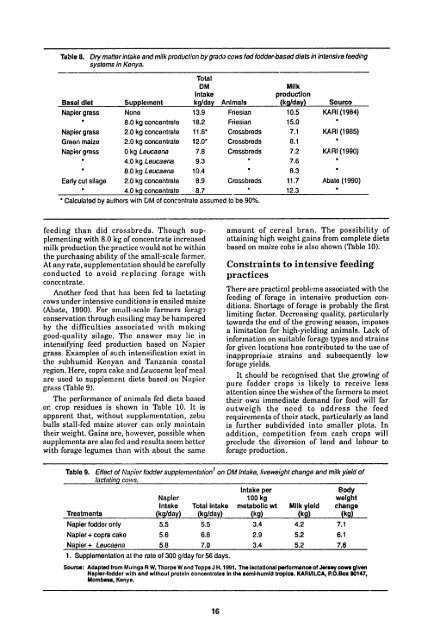aistand south~ern afrkca - (PDF, 101 mb) - USAID
aistand south~ern afrkca - (PDF, 101 mb) - USAID
aistand south~ern afrkca - (PDF, 101 mb) - USAID
Create successful ePaper yourself
Turn your PDF publications into a flip-book with our unique Google optimized e-Paper software.
Table 1. Dry matter intake and milk production by grade cows fed fodder-based diets in intensive feeding<br />
systems in Kenya.<br />
Total<br />
DM Milk<br />
Intake productlon<br />
Basal diet Supplement kq/day Animals (kg/day) Source<br />
Napier grass None 13.9 Friesian 10.5 KARl (1984)<br />
8.0 kg concentrate 18.2 Friesian 15.0<br />
Napier grass 2.0 kg concentrate<br />
°<br />
11.6 Crossbreds 7.1 KARl (1985)<br />
Green maize 2.0 kg concentrate 12.0* Crossbreds 8.1<br />
Napier grass 0 kg Leucaena 7.8 Crossbrods 7.2 KARl (1990)<br />
4.0 kg Leucaena 9.3 7.6<br />
8.0 kg Leucaena 10.4 8.3<br />
Early cut silage 2.0 kg concentrate 8.9 Crossbreds 11.7 Abate (1990)<br />
4.0 kg concentrate 8.7 " 12.3<br />
Calculated by authors with DM of concentrate assumed to be 90%.<br />
feeding than did crossbreds. Though sup- amount of cereal bran. The possibility of<br />
plementing with 8.0 kg of concentrate increased attaining high weight gains from complete diets<br />
milk production the practice would not be within based on maize cobs is also shown (Table 10).<br />
the purchasing ability of the small-scale farmer.<br />
At any rate, supplementation should be carefully Constraints to intensive feeding<br />
conducted to avoid replacing forage with practices<br />
concentrate.<br />
Another feed that has been fed to lactating<br />
cows under intensive conditions is ensiled maize<br />
(Abate, 1990). For small-scale farmers forag3<br />
(Absevat n h elimiting<br />
There are practical problems associated with the<br />
feeding of forage in intensive production con<br />
ditions. Shortage of forage is probably the first<br />
factor. Decreasing quality, particularly<br />
conservation through ensiling may be hampered towards the end of the growing season, imposes<br />
by the difficulties associated with making a limitation for high-yielding animals. Lack of<br />
good-quality silage. The answer may lie in information on suitable forage types and strains<br />
intensifying feed production based on Napier for given locations has contributed to the use of<br />
grass. Examples of such intensification exist in inappropriate strains and subsequently low<br />
the subhumid Kenyan and Tanzania coastal forage yields.<br />
region. Here, copra cake and Leucaena leaf meal It should be recognised that the growing of<br />
are used to supplement diets based on Napier pure fodder crops is likely to receive less<br />
grass (Table 9). attention since the wishes of the farmers to meet<br />
The performance of animals fed diets based their own immediate demand for food will far<br />
or crop residues is shown in Table 10. It is outweigh the need to address the feed<br />
apparent that, without supplementation, zebu requirements of their stock, particularly as land<br />
bulls stall-fed maize stover can only maintain is further subdivided into smaller plots. In<br />
their weight. Gains are, however, possible when addition, competition from cash crops will<br />
supplements are also fed and results seem better preclude the diversion of land and labour to<br />
with forage legumes than with about the same forage production.<br />
Table 9. Effect of Napier fodder supplementation i on DM intake, liveweight change and milk yield of<br />
lactating cows.<br />
Intake per Body<br />
Napier 100 kg weight<br />
Intake Total Intake metabolic wt Milk yield change<br />
Treatments (kgVday) (kglday) (kg) (kg) (kg)<br />
Napier fodder only 5.5 5.5 3.4 4.2 7.1<br />
Napier+ copra cake 5.6 6.8 2.9 5.2 6.1<br />
Napier+ Leucaena 5.8 7.0 3.4 5.2 7.6<br />
1. Supplementation at the rate of 300 g/day for 56 days.<br />
Source: Adapted from Mulnga R W, Thorpe Wand Toppa J H. 1991. The lactatlonal performance of Jerse cows given<br />
Napior-fodder with and without protein concentrates in the semi-humid tropics. KARIALCA, P.O.Box 80147,<br />
Mo<strong>mb</strong>asa, Kenya.<br />
16

















